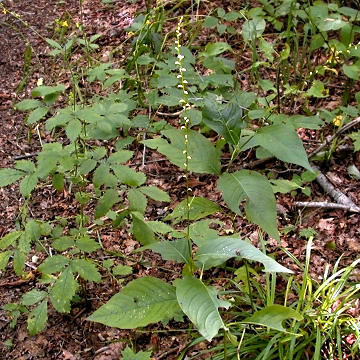

Polygonum virginianum - (image 1 of 5)
Taxonomy
Family: Polygonaceae
Habitat
Moist woodlands; wooded floodplains.
Associates
Distribution
NH west to MN and NE, south to FL and TX.
Morphology
Rhizomatous perennial to 1 m; stems often branched, erect, often with several inflorescences; ocreae pubescent and ciliate. Leaves mainly cauline, lanceolate to ovate, to 15 cm, acuminate, on petioles to 2 cm. Flowers greenish-white or pinkish, widely spaced on long, terminal, slender racemes; tepals 4; styles 2, elongate, persistent, becoming indurated (hardened), connivent (fused), and deflexed (bent downward) in fruit.
Notes
Flowers July to September
Wetland indicator: Facultative
There are several synonyms for this species including Antenoron virgianum (L.) Roberty & Vautier, Persicaria virginiana (L.) Gaertn, and Tovara virginiana (L.) Raf. The currently accepted name by ITIS (Interagency Taxonomic Information System) is the one used here.
There seems to be a rumor circulating around the internet that an official name change of the genus Polygonum to Persicaria has taken place. It is not uncommon to see it stated that Persicaria is the "new" name for Polygonum or something to that effect. This may be the result of a Wikipedia article that says as much without providing any supporting sources. While it is true that the genus Polygonum is typically divided into several sections (and these sections have been recognized as genera by some authorities), the concept of placing this species in Persicaria is certainly not new considering that it was first proposed by Joseph Gaertner in the late 1700's.
References
Gleason, Henry A. and A. Cronquist. 1991. Manual of Vascular Plants of Northeastern United States and Adjacent Canada. Second Ed.
The New York Botanical Garden. Bronx, NY
ITIS. Polygonum virginianum L. Taxonomic Serial No.: 20931. Retrieved May 12, 2010 from the Integrated Taxonomic Information System on-line database, http://www.itis.gov
Swink, F. and G. Wilhelm. 1994. Plants of the Chicago Region.
Indiana Academy of Science. The Morton Arboretum. Lisle, Illinois.
|
Michael Hough © 2010 |